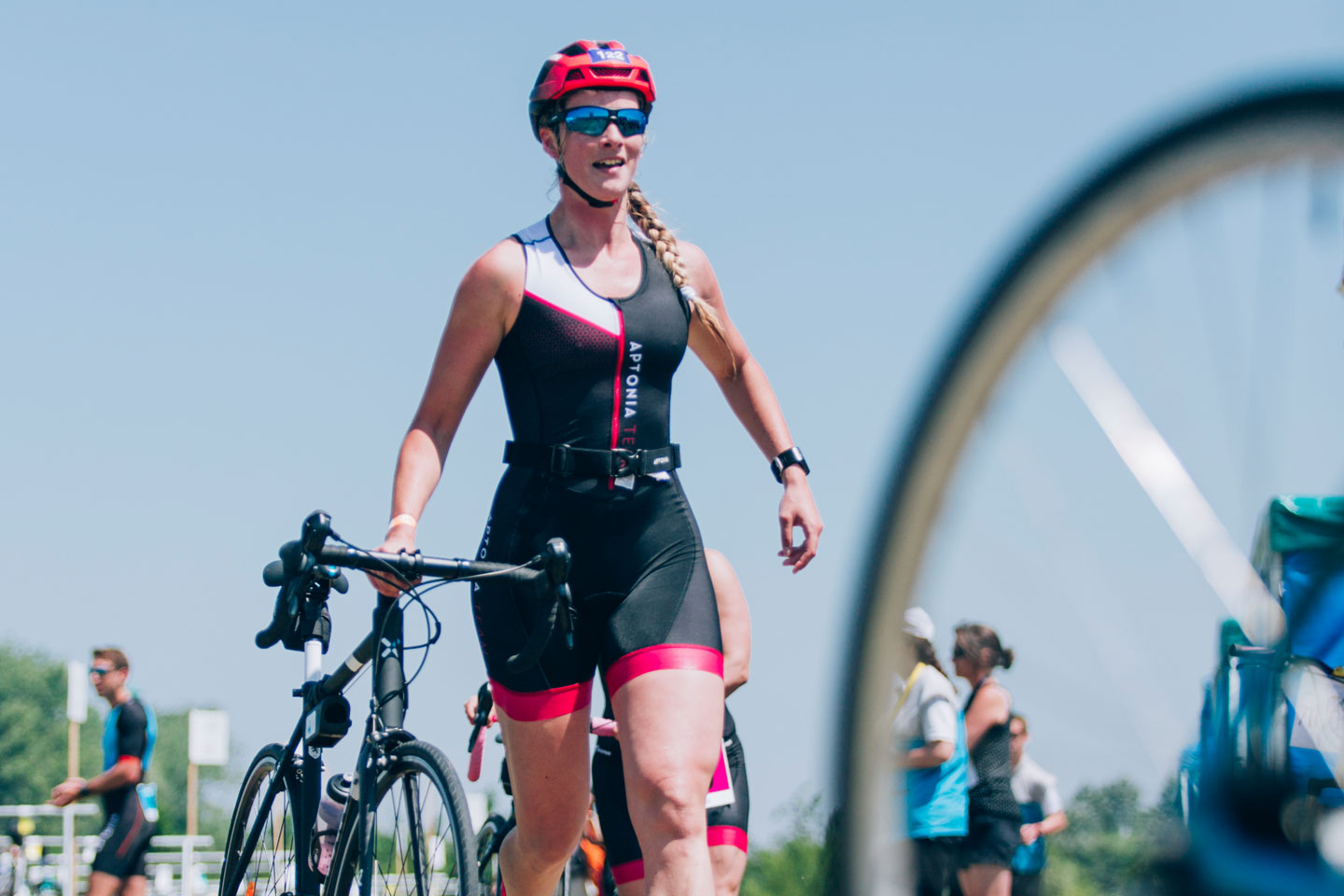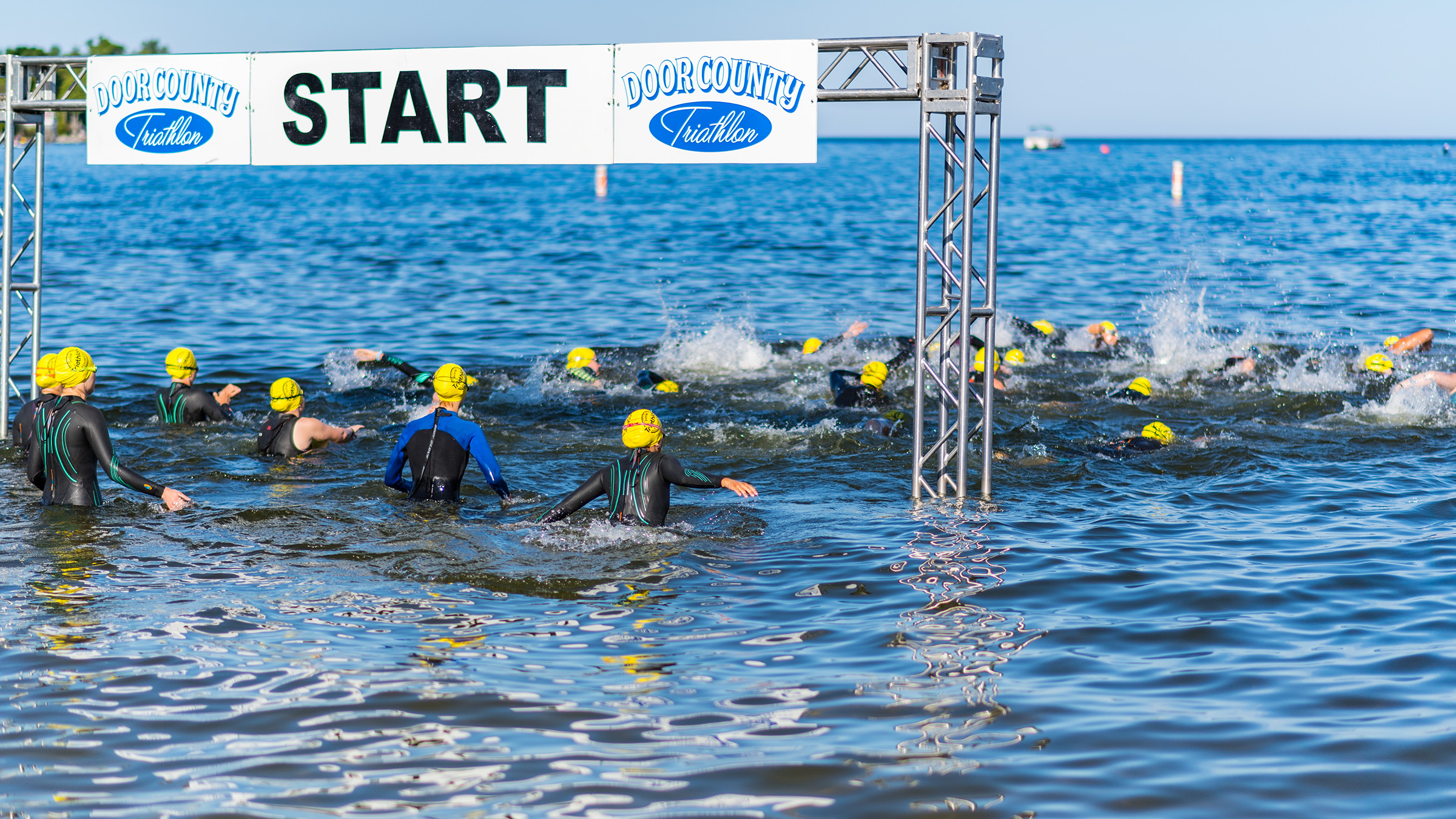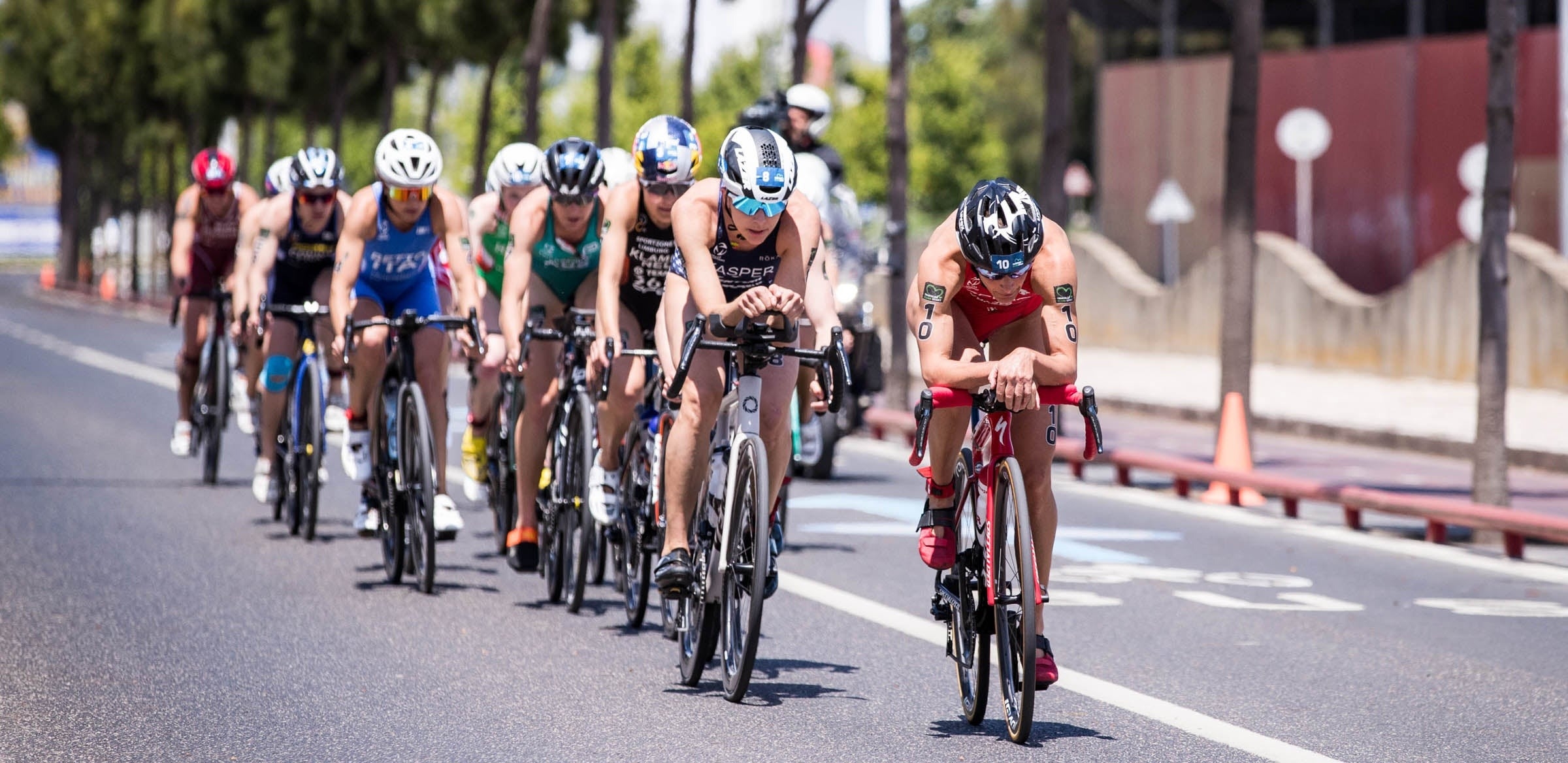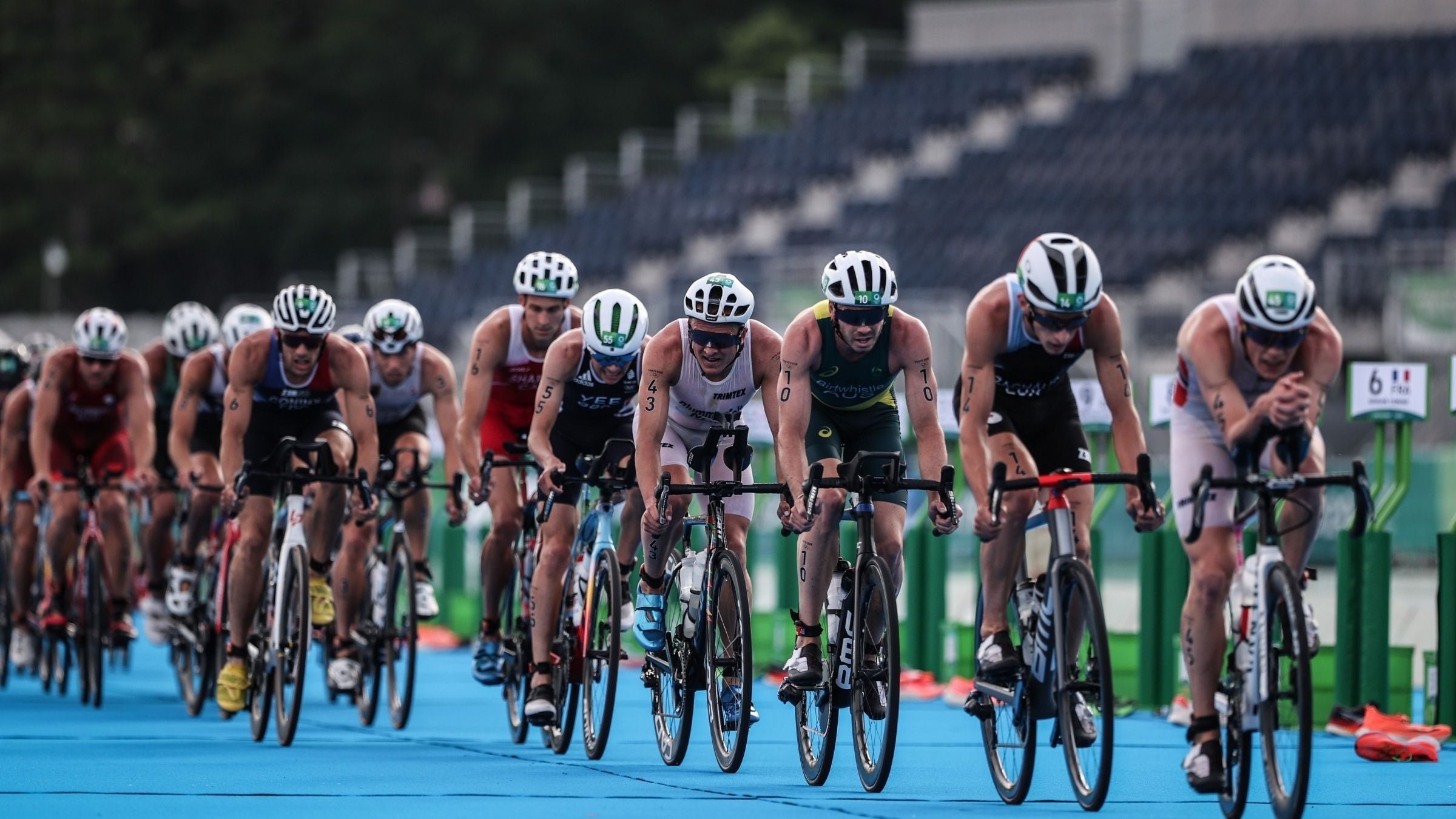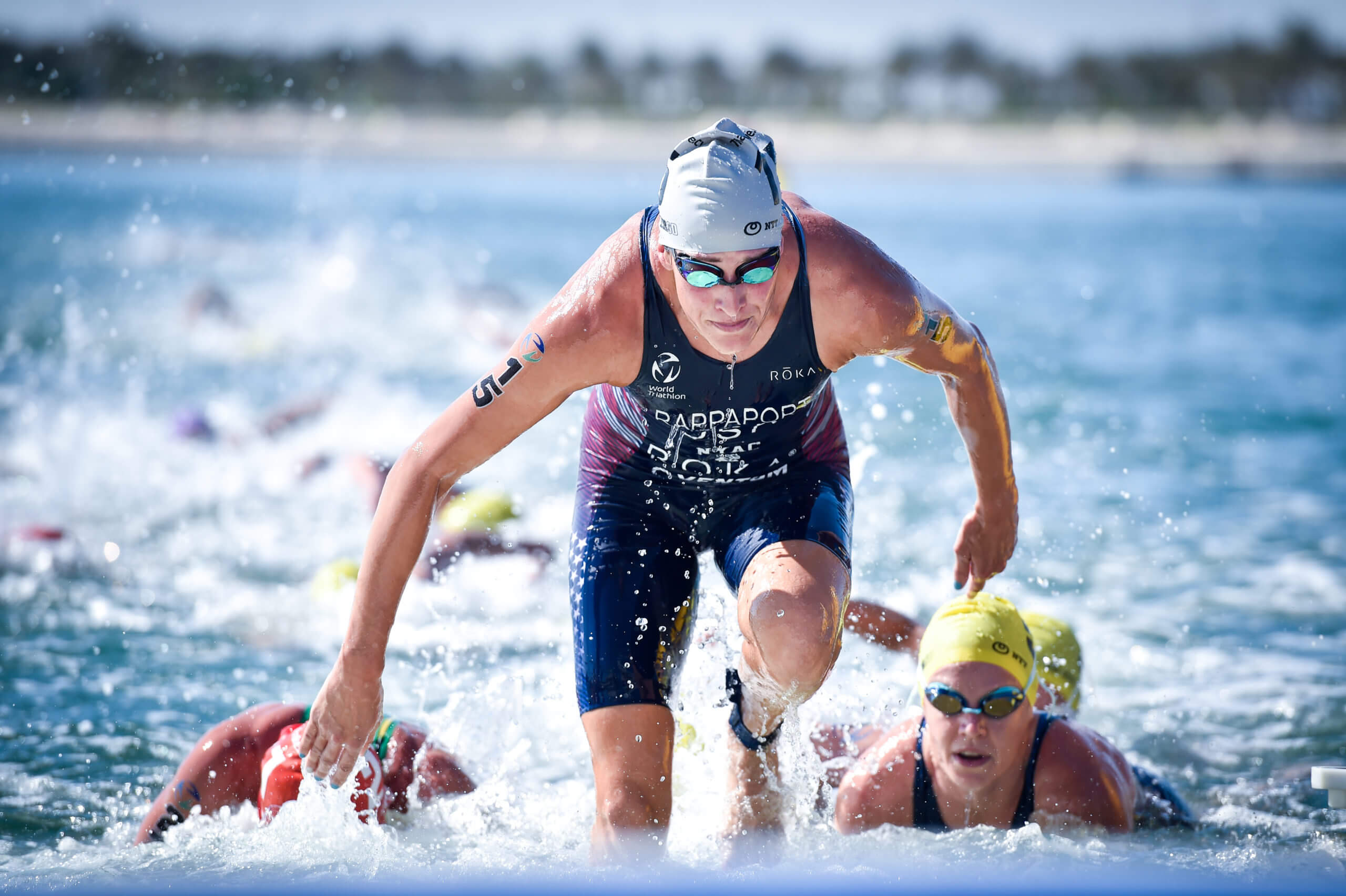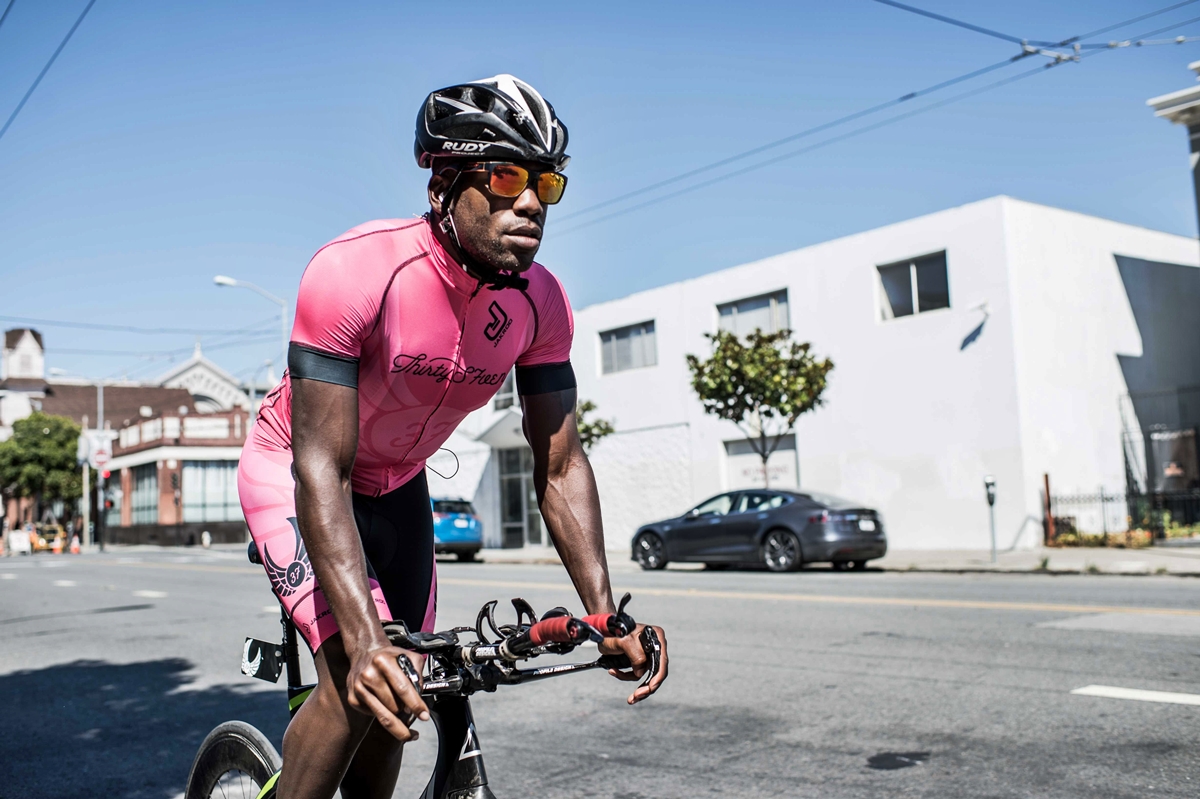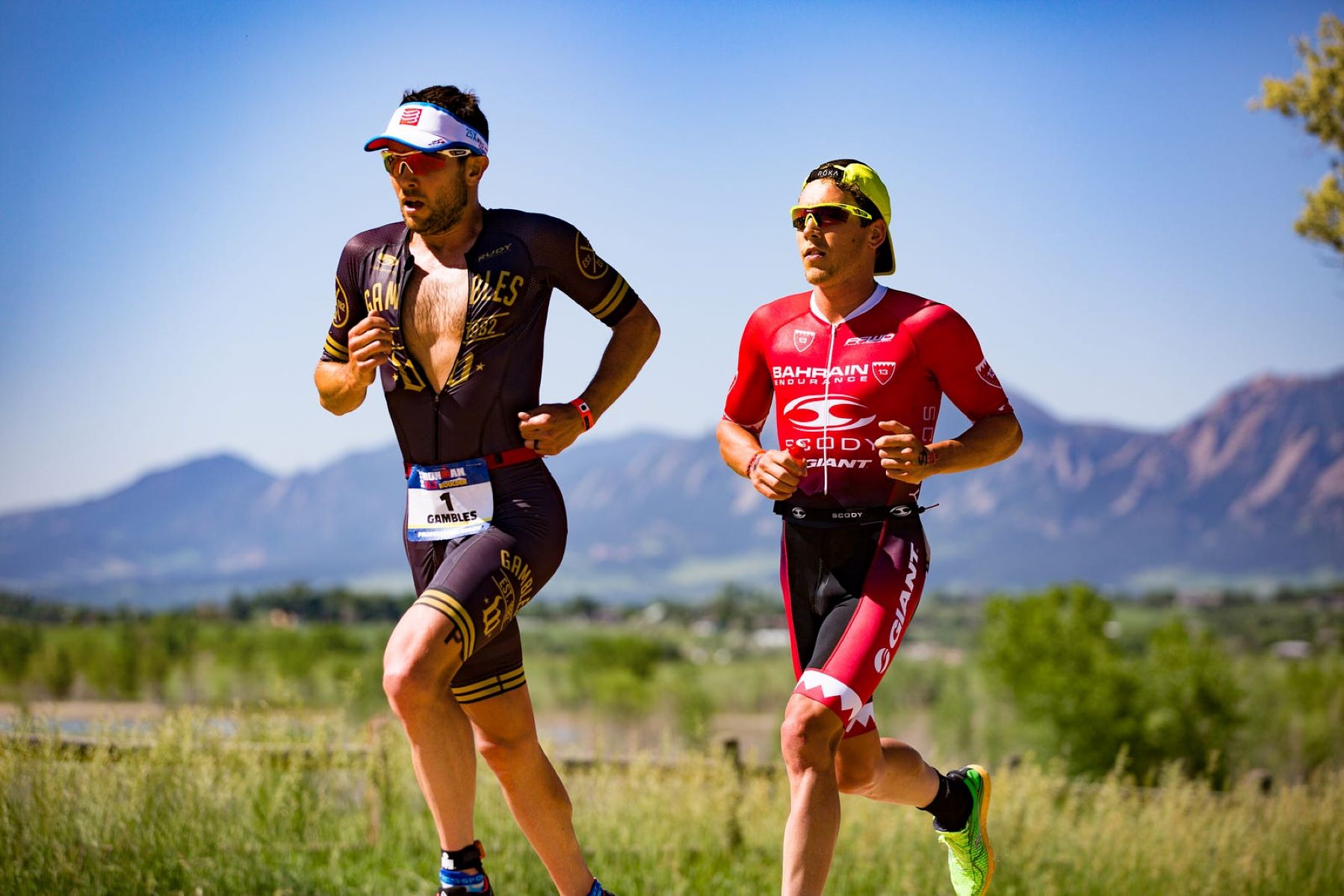

Featured
How To Train For A Sprint Triathlon
Modified: August 21, 2023
Learn how to train for a sprint triathlon with our featured guide. Get expert tips and strategies to maximize your performance and reach the finish line strong.
Introduction
Welcome to the exciting world of sprint triathlon training! Whether you are a seasoned athlete or a beginner looking to challenge yourself, participating in a sprint triathlon can be a rewarding and fulfilling experience. A sprint triathlon typically consists of a 750-meter swim, a 20-kilometer bike ride, and a 5-kilometer run. It requires a balanced combination of endurance, strength, and mental fortitude.
Training for a sprint triathlon is not just about completing the three disciplines individually, but also about efficiently transitioning between them. It demands dedication, discipline, and proper planning. But don’t worry – with the right mindset and a well-structured training plan, you can successfully cross the finish line and achieve your triathlon goals.
In this article, we will explore the key aspects of training for a sprint triathlon, offering valuable insights and practical tips to help you make the most out of your triathlon journey. So, let’s dive right in!
Setting Your Goals
Before you begin your sprint triathlon training, it’s crucial to set clear and realistic goals. Your goals will serve as a guiding force throughout your training journey, helping you stay motivated and focused. Here are a few factors to consider when setting your triathlon goals:
- Distance and Time: Determine the specific distance and target time you want to achieve in each discipline. This will allow you to tailor your training plan accordingly and track your progress.
- Finish vs. Performance: Decide whether your ultimate goal is just to finish the triathlon or to perform at a certain level. This will influence the intensity and focus of your training.
- Personal Challenges: Consider any areas of weakness or challenges you may have in the swim, bike, or run. Setting goals to overcome these challenges will help you improve and become a well-rounded triathlete.
- Long-term vs. Short-term Goals: Set both long-term goals, such as completing multiple triathlons in a season, and short-term goals, such as improving your swim time or increasing your cycling distance.
Remember to make your goals realistic and achievable. While it’s essential to push yourself, setting goals that are too unrealistic can lead to frustration or burnout. Break down your larger goals into smaller milestones, making them more manageable and measurable.
Additionally, it can be helpful to set process-oriented goals rather than solely outcome-based goals. Focus on things within your control, such as following your training plan consistently, improving your technique, or incorporating strength training. This shift in mindset will keep you motivated and allow you to celebrate small victories along the way.
Lastly, ensure your goals align with your personal priorities and schedule. Consider any time constraints, work commitments, or other responsibilities you have. Finding the right balance between training and other aspects of your life is key to maintaining a healthy and sustainable triathlon journey.
Creating a Training Plan
Creating a well-structured training plan is essential for preparing yourself physically and mentally for a sprint triathlon. A comprehensive training plan should include a balance of all three disciplines (swim, bike, and run), as well as strength and conditioning exercises, rest days, and mental preparation. Here are some steps to help you create an effective training plan:
- Evaluate Your Current Fitness: Assess your current fitness level in each discipline to determine your starting point. This will help you tailor your training plan according to your specific needs and abilities.
- Set a Training Schedule: Determine how many days a week you can commit to training and divide them among the three disciplines. Aim for a balance that allows you to improve in each area without overexerting yourself.
- Progression and Periodization: Gradually increase the intensity and duration of your workouts over time. This principle of progression and periodization helps prevent injuries and allows for optimal performance during the triathlon.
- Include Rest Days: Rest days are just as important as training days. They allow your body to recover and adapt to the physical demands of the training. Plan at least one or two rest days per week.
- Transition Workouts: Incorporate specific transition workouts to practice moving seamlessly from one discipline to another. These workouts help improve your mental and physical readiness for the race.
- Mix It Up: Keep your training plan interesting and challenging by varying the types of workouts you do. Include interval training, hill workouts, long endurance sessions, and technique-focused sessions to improve different aspects of your performance.
- Listen to Your Body: Pay attention to any signs of fatigue or overtraining. Adjust your training plan as needed to avoid burnout and minimize the risk of injuries. It’s better to have a slightly lighter training session than to push through when your body needs rest.
- Track Your Progress: Regularly evaluate your progress and make adjustments to your training plan as needed. Keep a training log to record your workouts, track your improvements, and identify any areas that may need more attention.
Remember, your training plan should be flexible and adaptable to accommodate unforeseen circumstances or changes in your schedule. Most importantly, approach your training with a positive mindset and enjoy the process. Embrace the challenges and celebrate your progress along the way to the triathlon.
Swim Training
Swimming is often the most challenging discipline for many triathletes, especially those who are new to the sport. Building swim-specific endurance, improving technique, and enhancing overall efficiency in the water are key objectives in swim training for a sprint triathlon. Here are some tips to help you make the most out of your swim training:
- Focus on Technique: Work on improving your swim technique to swim more efficiently and conserve energy. Consider enrolling in swim lessons or working with a swim coach to refine your stroke and breathing technique.
- Include Drills: Incorporate swim drills into your training sessions to enhance specific aspects of your stroke. Drills such as kick drills, catch-up drills, and one-arm drills can help improve your form and body position in the water.
- Build Endurance: Gradually increase the distance you swim during training to build endurance. Start with shorter distances and gradually work your way up to the race distance. Interval training can help improve both speed and endurance.
- Open Water Practice: If your race takes place in open water, try to incorporate open water swim practices. Familiarize yourself with swimming in a different environment, practice sighting, and get comfortable swimming in a crowd.
- Practice Transitions: Include transition workouts where you practice moving from the swim to the bike. Simulate the process by quickly removing your wetsuit (if applicable) and transitioning into cycling gear.
- Pool Etiquette: If you train in a pool, be mindful of pool etiquette and lane sharing. Be aware of other swimmers and practice good lane etiquette to ensure a smooth and respectful training environment.
- Mental Preparation: Use visualization techniques to mentally prepare yourself for the swim portion of the triathlon. Imagine yourself confidently swimming through the course and successfully completing each stroke.
Remember to prioritize safety during your swim training. Always swim in designated swimming areas, wear a swim buoy for visibility in open water, and never swim alone if possible. With consistent training, focus on technique, and building swim-specific endurance, you will gain confidence in the water and be ready to tackle the swim portion of your sprint triathlon.
Bike Training
Bike training is a crucial component of preparing for a sprint triathlon. It not only helps to build cardiovascular endurance but also improves leg strength and overall cycling efficiency. Here are some tips to make the most out of your bike training sessions:
- Get the Right Equipment: Ensure you have a well-maintained bike that fits you properly. Visit a bike shop to get a professional bike fitting and make any necessary adjustments to ensure comfort and optimal performance.
- Start with Base Mileage: Begin your bike training with longer, steady rides at a comfortable pace to build your base mileage and endurance. Aim for gradual increases in distance to avoid overexertion.
- Mix Up Your Training: Include a mix of endurance rides, interval training, and hill repeats in your bike training plan. This variety helps improve cardiovascular fitness, strength, and power output.
- Practice Transitions: Incorporate transition workouts where you practice moving from the bike to the run. This helps your body adapt to the sensations of running immediately after cycling.
- Focus on Technique: Work on your cycling technique, paying attention to your pedal stroke, cadence, and body position. Practice maintaining a steady rhythm and efficient pedaling to maximize power output.
- Simulate Race Conditions: If possible, train on similar terrain and conditions that you expect to encounter during the triathlon. This helps you become familiar with the course and mentally prepares you for the race.
- Stay Safe: Always prioritize safety during your bike training. Observe traffic rules, wear a helmet, and use proper signaling when turning or changing lanes. Additionally, be aware of your surroundings and respect other road users.
- Nutrition and Hydration: Practice fueling and hydrating during your long rides to determine what works best for you. Experiment with different energy gels, bars, and drinks to find what provides the necessary nutrients and hydration without causing any digestive issues.
Remember to gradually increase the intensity and duration of your bike training sessions to avoid overtraining and minimize the risk of injury. Incorporate rest and recovery days into your training plan to allow your muscles to repair and adapt to the physical demands of cycling. With consistent training and attention to technique and safety, you will enhance your cycling performance and be well-prepared for the bike leg of your sprint triathlon.
Run Training
Running is the final discipline of a sprint triathlon and can often be the most physically demanding. Building running endurance, improving speed, and maintaining good form are crucial for a successful race. Here are some tips to enhance your run training:
- Gradual Progression: Gradually increase your running mileage and intensity to build endurance and prevent overuse injuries. Start with shorter distances and gradually build up to the race distance.
- Include Different Types of Runs: Incorporate a mix of long runs, tempo runs, interval training, and hill repeats to improve different aspects of your running fitness. Varying the intensity and duration of your runs will help improve both speed and endurance.
- Focus on Form: Pay attention to your running form, including posture, stride length, and cadence. Practice running with a relaxed upper body, a slight forward lean, and aiming for a mid-foot strike. Good form will make your running more efficient and help prevent injuries.
- Strength Training and Cross-training: Include strength training exercises such as squats, lunges, and core work to improve overall running strength and reduce the risk of injuries. Incorporate cross-training activities like cycling or swimming to give your running muscles a break while maintaining cardiovascular fitness.
- Practice Brick Workouts: Incorporate brick workouts into your training plan, where you combine a bike ride immediately followed by a run. This helps your body adapt to the sensations of running off the bike and improves your transition between the two disciplines.
- Know Your Race Pace: Practice running at your desired race pace during training runs to familiarize yourself with the speed and effort required. This will give you a better understanding of your capabilities and help you pace yourself during the race.
- Pay Attention to Nutrition and Hydration: Practice fueling and hydrating during your training runs to determine what works best for you. It’s important to maintain proper nutrition and hydration to support your energy levels during the run leg of the triathlon.
- Mental Strength: Running can be mentally challenging, especially during longer distances. Develop mental strategies like positive self-talk, visualization, and breaking down the run into smaller goals to help stay motivated and focused during the race.
Remember to listen to your body and incorporate rest days into your training plan to allow for recovery and prevent overtraining. Proper rest and recovery are essential in improving performance and reducing the risk of injuries. With consistent training, a focus on form, and a positive mindset, you’ll be well-prepared to conquer the run leg of your sprint triathlon.
Transition Training
Transition training is a crucial aspect of preparing for a sprint triathlon as it focuses on the seamless and efficient movement between each discipline. Transitions can make a significant difference in your overall race time, so it’s essential to practice and perfect your transition skills. Here are some tips to help you excel in transition training:
- Set Up Transition Area: Familiarize yourself with the transition area layout. Organize your equipment strategically to minimize transition times. Practice setting up your bike and running gear in a consistent and efficient manner.
- Practice Transitions: Incorporate transition workouts in your training plan. Simulate the transitions by quickly moving from swim to bike and bike to run. Focus on smooth and swift gear changes, removing wetsuits (if applicable), and putting on shoes and accessories efficiently.
- Visualize the Transitions: Mentally rehearse the transition process before the race. Visualize each step, including what equipment you need and the order in which you will put them on or take them off. This mental preparedness will help you stay focused and calm during the race.
- Practice Mounting and Dismounting: Practice mounting and dismounting your bike smoothly to save valuable seconds during the race. Develop a technique that works for you, such as mounting from a running start or using a flying dismount.
- Timing and Efficiency: Focus on improving your overall transition time without rushing and causing mistakes. Practice transitioning quickly and efficiently while maintaining composure and accuracy.
- Mock Race Simulations: Conduct mock race simulations in the weeks leading up to the event. Include swim-to-bike and bike-to-run transition segments in a practice triathlon. This will help you become accustomed to the unique physical and mental demands of transitioning between disciplines.
- Minimize Distractions: Eliminate potential distractions by keeping your transition area clutter-free. Securely fasten your gear to avoid any mishaps during the race. Streamline your process by eliminating unnecessary items from your transition setup.
- Ask for Assistance: If you’re unsure about any aspect of transitions, don’t hesitate to seek guidance from experienced triathletes or coaches. They can provide valuable tips and tricks to improve your transition skills.
Remember, transitions are an often overlooked but critical part of a sprint triathlon. Practice and preparation will help you execute smooth and efficient transitions, giving you a competitive edge during the race. By incorporating specific transition workouts and visualizing the process, you’ll enhance your overall race experience and improve your chances of a successful triathlon.
Strength and Conditioning Exercises
Incorporating strength and conditioning exercises into your training plan is crucial for building overall strength, improving muscular endurance, and preventing injuries. Here are some key exercises to consider during your sprint triathlon training:
- Squats and Lunges: These compound exercises target the major muscle groups in your lower body, including the quads, hamstrings, and glutes. They help improve leg strength and stability, important for both cycling and running.
- Planks and Core Exercises: Develop a strong core with exercises like planks, sit-ups, and Russian twists. A strong core helps maintain proper body position during all three disciplines and enhances overall stability and balance.
- Push-ups and Dips: Strengthen your upper body with exercises like push-ups and dips. These exercises target the chest, shoulders, and triceps, which are essential for maintaining good form during your swim and providing power during your run.
- Pull-ups and Rows: Improve your upper body strength and posture with exercises like pull-ups and rows. These exercises target the back muscles and help counteract muscle imbalances that can occur due to the forward-leaning positions in swimming and cycling.
- Single-Leg Exercises: Incorporate single-leg exercises such as single-leg squats and step-ups to improve balance, stability, and strength. These exercises can help address any imbalances between your left and right sides.
- Functional Training: Include exercises that mimic the movements and demands of the triathlon. For example, incorporate stability ball exercises, medicine ball throws, or kettlebell swings to improve overall functional strength and power.
- Flexibility and Mobility Work: Dedicate time to working on flexibility and mobility exercises, such as dynamic stretches, yoga, or foam rolling. These activities help improve range of motion and reduce the risk of injury.
- Strength Training Periodization: Structure your strength training sessions into different phases, progressively increasing intensity and incorporating variety. This periodization approach helps avoid plateaus, promotes ongoing improvements, and prepares your body for peak performance during the triathlon.
- Recovery and Rest: Allow for adequate recovery between strength training sessions to allow your muscles to repair and grow. Include rest days in your training plan to ensure overall recovery and optimize performance.
Remember, strength and conditioning exercises should complement your triathlon training and not interfere with it. Be mindful of not overtraining or neglecting the primary disciplines of swimming, cycling, and running. Consult with a fitness professional to tailor a strength and conditioning program that aligns with your training goals and specific needs as a triathlete.
Nutrition and Hydration
Nutrition and hydration play a vital role in your sprint triathlon performance. Proper fueling before, during, and after training sessions and the race itself can significantly impact your energy levels, endurance, and overall performance. Here are some key guidelines to consider for optimal nutrition and hydration:
- Pre-Race Meal: Consume a balanced meal consisting of carbohydrates, lean proteins, and healthy fats a few hours before the race. This provides a steady release of energy and helps prevent digestive discomfort. Avoid trying new foods or heavy meals that may lead to gastrointestinal issues.
- Stay Hydrated: Stay hydrated leading up to the race and during training sessions. Aim to drink water regularly throughout the day and replenish fluids lost through sweat. Drink according to your thirst, and consider sports drinks or electrolyte supplements during longer training sessions to replace essential minerals lost through sweat.
- Fueling During Training: Practice fueling during your longer training sessions to determine what works best for you. Experiment with energy gels, chews, or other easily digestible snacks to provide a source of carbohydrates and maintain energy levels during exercise. Don’t forget to hydrate adequately during workouts as well.
- Post-Workout Nutrition: Consume a combination of carbohydrates and protein within 30 minutes of finishing your training session. This helps replenish glycogen stores, repair muscle tissue, and enhance recovery. Opt for whole foods such as lean meats, fruits, vegetables, and whole grains, or consider a recovery shake or bar if convenient.
- Balance Your Macronutrients: Maintain a well-balanced diet that includes carbohydrates, proteins, and healthy fats. Carbohydrates provide energy, proteins support muscle repair and growth, and healthy fats are important for hormonal balance and overall health.
- Eat Real, Whole Foods: Prioritize real, whole foods over processed or packaged alternatives. Choose nutrient-dense foods such as fruits, vegetables, lean proteins, whole grains, and healthy fats to provide essential vitamins, minerals, and antioxidants for optimal performance and recovery.
- Listen to Your Body: Pay attention to your body’s cues and adjust your nutrition and hydration accordingly. Everyone’s nutritional needs are different, so experiment with different foods, timing, and quantities to find what works best for you.
- Practice Race Nutrition: During your training, simulate race-like conditions by practicing your nutrition and hydration strategies. This allows you to fine-tune your plan before the actual triathlon, ensuring that you fuel and hydrate adequately during the race.
- Consult a Sports Nutritionist: If you’re unsure about your specific nutritional needs or have any dietary concerns, consider consulting a sports nutritionist. They can provide personalized advice and guidance to help optimize your nutrition plan for the best triathlon performance.
Remember, nutrition and hydration are individualized, so it’s important to find what works best for your body through trial and error during training. Make sure to practice your nutrition and hydration strategies during training sessions to ensure they are effective for race day. By fueling your body properly, you can maximize your energy levels, enhance your endurance, and perform at your best during your sprint triathlon.
Rest and Recovery
Rest and recovery are often overlooked aspects of training, yet they are crucial for maximizing performance and preventing injuries in a sprint triathlon. Your body needs adequate time to recover and adapt to the physical demands of training. Here are some key considerations for incorporating rest and recovery into your triathlon training:
- Rest Days: Schedule regular rest days throughout your training plan. These days allow your body to repair and rebuild muscle tissue, reducing the risk of overuse injuries and preventing burnout. Use rest days for light activities, stretching, or complete rest, depending on how your body feels.
- Quality Sleep: Prioritize getting enough high-quality sleep each night. Sleep is essential for the body’s recovery and repair processes. Aim for 7-9 hours of uninterrupted sleep to support optimal performance and overall well-being.
- Active Recovery: Incorporate active recovery days into your training plan. Engage in low-intensity, low-impact activities such as walking, swimming, or gentle stretching to promote blood flow, reduce muscle soreness, and aid in recovery.
- Listen to Your Body: Pay attention to any signs of fatigue, excessive soreness, or decreased performance. If you’re feeling overly fatigued or experiencing persistent pain, give your body additional rest and recovery time. Pushing through signs of overtraining can lead to injuries and hinder your progress.
- Massage or Foam Rolling: Consider incorporating massage or foam rolling into your recovery routine. These techniques help relieve muscle tension, improve circulation, and promote faster recovery. Focus on areas that tend to be tight, such as the calves, quadriceps, hamstrings, and IT bands.
- Hydration and Nutrition: Proper hydration and nutrition play a key role in recovery. Drink plenty of water throughout the day to stay hydrated and support optimal muscle function. Consume a balanced diet with adequate protein, carbohydrates, and healthy fats to aid in muscle repair and replenishment of energy stores.
- Stress Management Techniques: Manage stress levels through techniques such as deep breathing, meditation, or yoga. Stress can hinder recovery and negatively impact performance, so finding ways to relax and unwind is essential for overall well-being.
- Periodization: Incorporate periodization into your training plan, which involves structured cycles of training intensity and volume. This allows for proper recovery after intense training blocks and helps prevent overtraining.
- Cross-Train: Include cross-training activities such as swimming or cycling to reduce the impact on your joints and muscles while still maintaining cardiovascular fitness. Cross-training also provides a mental break from your primary disciplines.
- Monitor Progress: Regularly assess your progress during training and make adjustments to your plan as needed. If you’re consistently feeling fatigued or not seeing improvements, consider reevaluating your training load or seeking guidance from a coach or trainer.
Remember, rest and recovery are essential components of your training journey. By giving your body the time it needs to recover, you’ll optimize your performance and reduce the risk of injuries. Listen to your body, prioritize sleep, and incorporate various recovery techniques to reap the benefits of a well-rested and rejuvenated body on race day.
Mental Preparation
Mental preparation is just as important as physical training when it comes to succeeding in a sprint triathlon. The ability to stay focused, motivated, and maintain a positive mindset can greatly impact your performance on race day. Here are some strategies to help you mentally prepare for your sprint triathlon:
- Set Positive Affirmations: Develop positive affirmations or mantras that you can repeat to yourself during training and on race day. These can serve as a reminder of your capabilities and help you stay focused and motivated when faced with challenges.
- Visualize Success: Spend time visualizing yourself successfully completing each discipline of the triathlon. Visualize crossing the finish line, feeling strong and confident during each leg of the race. This mental rehearsal helps build confidence and familiarizes your mind with success.
- Break It Down: Rather than overwhelming yourself with the entire triathlon, break it down into smaller goals. Focus on individual sections or mile markers to keep yourself motivated and focused without feeling overwhelmed.
- Practice Mental Toughness: During training, deliberately put yourself in challenging situations to practice mental toughness and resilience. Push yourself during difficult workouts or adverse weather conditions to build mental strength and prepare yourself for the unexpected during the race.
- Control Focus and Avoid Comparisons: Stay focused on your own performance and avoid comparing yourself to other athletes. Everyone has their own journey and abilities. Direct your attention to your own progress and celebrate your personal achievements.
- Stay Present: During the race, focus on the present moment rather than worrying about what lies ahead or what has already passed. Be fully present in your swim stroke, bike pedal, or running stride to maintain focus and perform at your best.
- Practice Positive Self-Talk: Replace negative thoughts and self-doubt with positive self-talk. Encourage yourself with uplifting words and remind yourself of your training, dedication, and preparation. Positive self-talk can help boost confidence and motivation when facing challenges.
- Embrace Race-Day Nerves: It’s normal to feel nervous before a race. Instead of fighting those nerves, embrace them as a sign that you care about your performance. Channel that nervous energy into positive excitement and use it to fuel your performance.
- Race Reconnaissance: Familiarize yourself with the racecourse and visualize yourself navigating each section. This mental preparation can help reduce anxiety and increase confidence on race day.
- Celebrate Small Wins: Acknowledge and celebrate your small victories during training and even on race day. Recognize and appreciate the progress you’ve made, no matter how small, to boost your confidence and maintain a positive mindset.
Remember, mental preparation is an ongoing process that requires practice and consistency. Incorporate these strategies into your training routine and daily life to cultivate a strong and resilient mindset. By focusing on the mental aspect of your sprint triathlon, you’ll be better equipped to handle the challenges that arise during the race and perform at your best.
Conclusion
Congratulations! You’ve reached the end of our comprehensive guide on training for a sprint triathlon. By now, you should have a solid understanding of the key components involved in preparing for this exciting and challenging event. Whether you’re a beginner or an experienced athlete, following a well-rounded training plan, incorporating strength and conditioning exercises, prioritizing nutrition and hydration, and taking care of your mental well-being will set you up for success.
Remember, setting clear and realistic goals, creating a structured training plan, and staying consistent and disciplined in your workouts are essential. Don’t forget to focus on technique, practice seamless transitions, and give yourself adequate rest and recovery. Mental preparation is equally important, as it can help you overcome obstacles, maintain a positive mindset, and stay motivated throughout your training and on race day.
Triathlon training is a journey that will push your physical and mental limits, but with dedication, perseverance, and a willingness to step outside your comfort zone, you’ll be amazed at what you can achieve. Embrace the challenges, celebrate each milestone, and savor the experience of crossing the finish line on race day.
As you embark on your training journey, remember to listen to your body, seek guidance from professionals when needed, and stay committed to your goals. Training for a sprint triathlon can be demanding, but the sense of accomplishment and personal growth you’ll experience throughout the process will make it all worthwhile.
So, lace up your running shoes, dive into the pool, and hop on your bike. The journey to becoming a sprint triathlete awaits. Good luck, have fun, and enjoy the incredible adventure that is training for and completing a sprint triathlon!
